Statewide, approximately 18% of ears were infested with corn earworm larvae. Corn is considered a nursery crop for corn earworm, allowing the pest to complete a lifecycle and then move on to other crops such as soybean, cotton, and peanut in August. There is a linear correlation between the infestation level in corn and the amount of soybean acreage that gets treated with insecticide for this pest. Please see the attached pdf for more details: CEW_survey_results_2018
Category Archives: Soybean
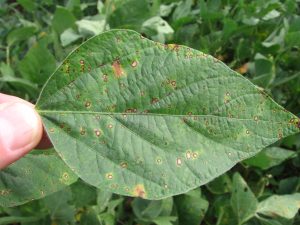
Walk Your Fields
For greater soybean yields, one of the best things that you can do is walk your fields. Many problems reveal themselves during the summer. Actions taken or not taken can be very noticeable. By walking fields, we can see what’s working and what’s not working. Certain problems can be solved, some cannot. For those that cannot be solved this year, we can do better next season by understanding why we have the problem. Therefore, a review of how to diagnose your crop will likely beneficial.
A few years ago, I published “Troubleshooting The Soybean Crop“. Although a little dated, most of the information is still good. This publication will guide you through how to go about diagnosing problems, includes a vegetative- and reproductive-stage outline with lots of photos, and also includes a sample crop scouting and diagnostic form. You can download a view a PDF copy, or contact me – I still have a few hard copies left. By following some general guidelines, one can become quite good at diagnosing problems. Below is a summary.
First, document everything! Memories tend to fade. We often forget or overlook details. You can document by taken notes (many phone apps or iPad/tablets work well for this). Make a recording. Take pictures – this is especially useful when you need help – and send those photos to others.
PRELIMINARY FACT FINDING. You can obtain plenty of information before you even get to the field. Although I call this preliminary (as if you’ve not seen the problem), you may need to go back to the office to refresh your memory of what you did. Information that can be acquired beforehand or back in the office includes: 
- Cropping History
- Equipment
- Soil Information
- Weather
- Pest Management Information
- Tillage and Other Cultural Practices
THE FIELD VISIT
- Take all materials and equipment needed (e.g., phones, paper, shovel, plastic bags, soil probes, etc.)
- Windshield/Whole Field Investigation
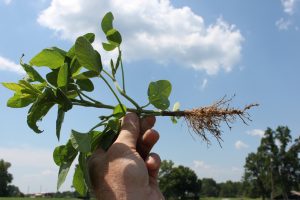
- Above-Ground Inspection
- Take Appropriate Plant or Soil Samples
- Equipment Check
- Interaction with Others
- Document Everything!
ANALYSIS OF DATA AND FINDINGS
- Patterns
- Look-Alike Symptoms
- Interacting Factors/More Than One Problem
DRAWING A CONCLUSION. Review the facts and data. Eliminate unlikely causes. Validate likely causes. You may be able to drawn a conclusion in the field, but lab analysis may be needed.
FOLLOW UP. Revisit the field. If you took corrective action, did it work? Why or why not?
This is a very rough outline of the guide. Again, if you want a hard copy of Troubleshooting The Soybean Crop, contact me.
Yellow soybean leaves may be due to manganese (Mn) deficiency
Manganese (Mn) deficiencies are common in Virginia soybean and are starting to appear in numerous fields. These deficiencies are not necessarily due to low Mn levels in the soil, but are more likely related to high soil pH levels, as its availability decreases with increasing soil pH.
Although soils with a pH of 6.2 or lower can occasional show Mn deficiencies, it is most likely to appear when pH levels reach 6.5 or above. Furthermore, Mn deficiencies are more common on our sandier soils because pH changes more rapidly and these soils typically have a lower concentration of the nutrient.
The deficiency will appear as interveinal chlorosis, usually on the younger leaves first since Mn is not a mobile nutrient. 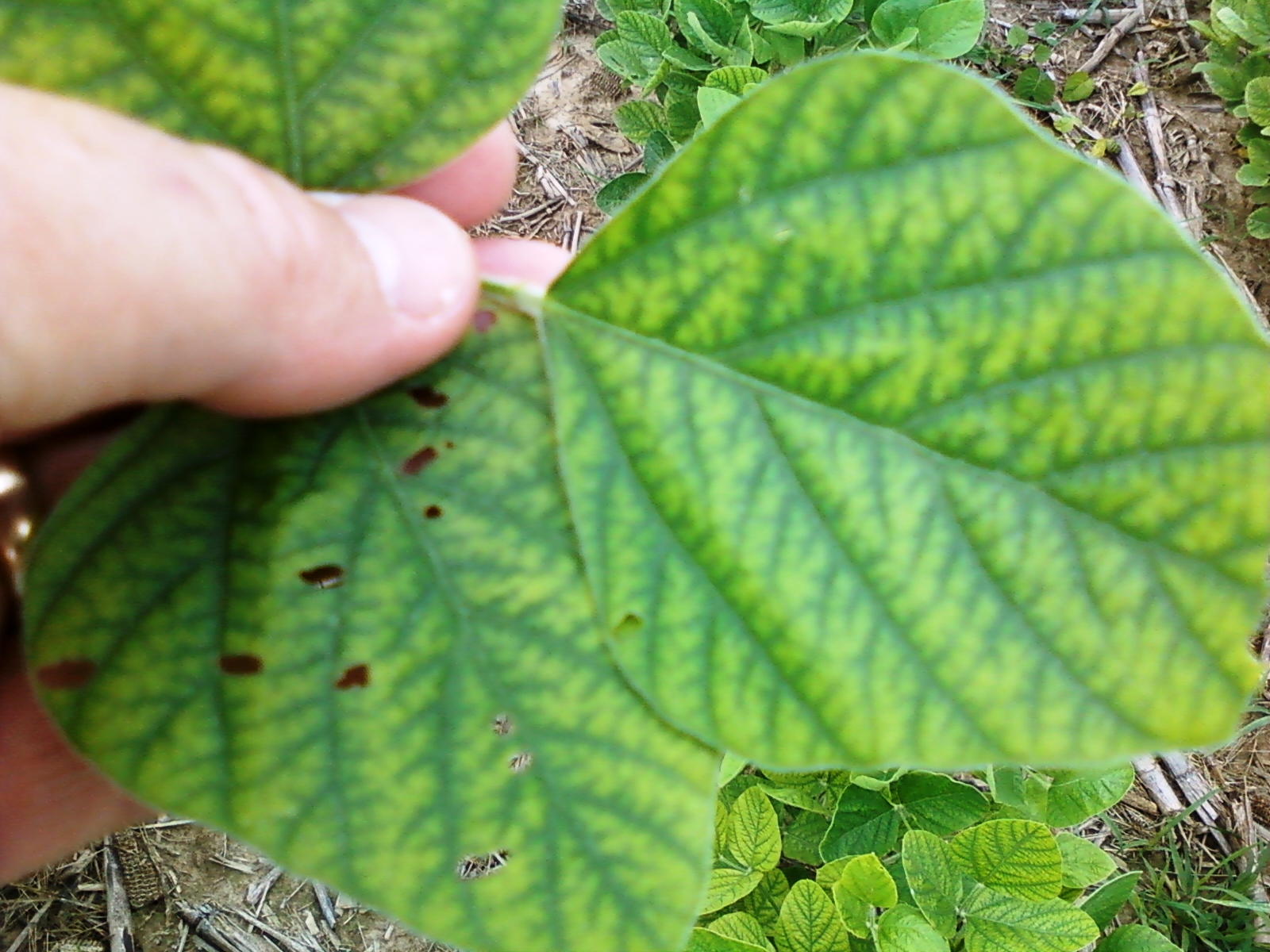 This may distinguish Mn deficiency from magnesium (Mg) deficiency. Magnesium deficiency symptoms will usually appear on the lower leaves while the upper leaves remain green. Still, I’ve seen Mn deficiency on the lower to middle leaves. This usually happens when the field has not been checked in a while and the observer missed the symptoms when they were on the younger leaves.
This may distinguish Mn deficiency from magnesium (Mg) deficiency. Magnesium deficiency symptoms will usually appear on the lower leaves while the upper leaves remain green. Still, I’ve seen Mn deficiency on the lower to middle leaves. This usually happens when the field has not been checked in a while and the observer missed the symptoms when they were on the younger leaves.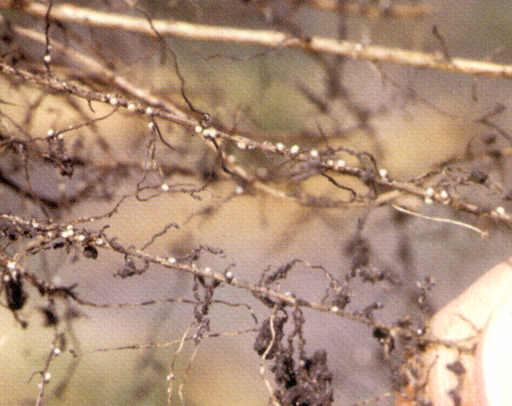
Other problems can cause look-alike symptoms similar to Mn deficiencies. In particular, interveinal yellowing is a common symptom of soybean cyst or other nematode damage. Therefore, it may be prudent to further investigate the problem, especially the root system.
Use the following guidelines for Mn applications:
Scout your fields. Mn deficiencies may or may not materialize. The only sure way to determine a deficiency is to observe the deficiency symptoms through visual observation or tissue tests. The characteristic visual symptom is yellowing between the veins on the new leaves. Mn is an immobile nutrient. Therefore, it will not move out of older leaves to the new leaves. Symptoms will appear when the plant can no longer extract sufficient amounts of the nutrient from the soil.
Take a tissue sample. If Mn deficiencies are suspected due to high pH and/or a field history of Mn deficiencies, but no symptoms have yet appeared, you should consider taking a tissue sample. Tissue samples can reveal deficiencies before symptoms appear (hidden hunger). We suggest a tissue test if lime, lime stabilized biosolids, or an ash product was recently applied.
Manganese application. To overcome a deficiency, apply ¾ lb. chelated Mn (elemental basis) or 1 lb. inorganic Mn (elemental basis) per acre to foliage upon appearance of symptoms and prior to flowering. More than one application may be required to correct a severe deficiency.
Don’t use low rates to correct a deficiency. Note that many Mn products recommend applying lower rates of Mn. However, the label usually states that these are maintenance rates. Once a deficiency occurs, these lower rates will not correct the deficiency and the rates stated above will be needed.
Split Mn application on deficiency-prone soils. An alternate method of application can be used before a deficiency is evident on soils that commonly show a deficiency, especially on soils that have a high pH (above 6.8 or so). A lower rate (~ ½ of that listed above) can be combined with another scheduled application, such as a postemergence herbicide or insecticide. This may be a sufficient rate to prevent a deficiency from occurring. But, continue to scout the field and take future corrective measures if visual deficiencies appear. If a visual symptom appears, you need to use the full rate. I will remind you that this is a preventative treatment. A deficiency may not occur. Furthermore, these are only maintenance rates and another application will likely be needed if the field is truly deficient.
Use EDTA chelated Mn formulations when mixing with glyphosate. Be reminded that some Mn formulations in combination with glyphosate herbicide (Roundup, Touchdown, many generics, etc.) will result in reduced weed control of certain weeds. Other herbicides have not shown to interact. If including Mn with glyphosate, use the EDTA chelated formulation as it has shown not to interact.
Don’t spray if you don’t need it. In addition to the cost, Mn can be toxic to soybean. Spraying greater than recommended rates or spraying as a preventative spray when soil pH is relatively low (5.7-5.9) could lead to toxicity problems
Weed Management Field Day TOMORROW
June 19th, 2018
8:30 to 11:30am
Location:
Southern Piedmont AREC
Field entrance near:
1200 Darvills Road
Blackstone, VA 23824
Google Maps link to field entrance: https://goo.gl/maps/iKZmYnjx7wM2
More information in the flyer: 2018 Weed Management Field Day Flyer
2017 Field Crop Disease & Nematode Management Trials
A summary of field crop disease and nematode management trials from 2017 is now available. Results for applied research on wheat, corn, cotton, peanut, and soybean can be downloaded below.
Wet Soils, Poor Stands – Do I Replant?
The decision of whether or not to replant arises every year; however, the wet soil conditions seem to have worsened the problem this year. There of course will be areas that the decision is easy – flooded areas resulting in almost no stand. But, what about fields that just are not living up to your expectations? I’ve seen and heard many reports of stands being reduced 25 to 50% of what was expected (keep in mind that our expectations are sometimes too high).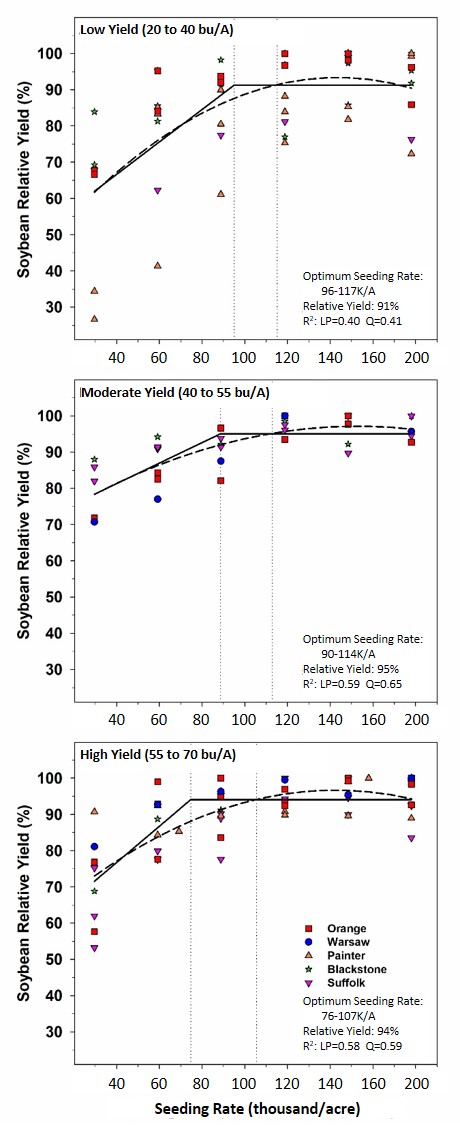
First, I must mention that final average stands of 60,000 to 80,000 plants/acre rarely profit from replanting. Only when you get below 50,000 can it be economically justified. I refer you to the seeding rate data shown. Note that yield does not fall off until seeding rates fall below 90 to 120 thousand seed/acre (76 to 107 seed/acre on productive soils). Stands generally averaged 75%; so, this is equal to 65 to 90 thousand plants/acre. Once you add in the cost and of and time required to replant, it’s not usually worth it – unless the stand less than this.

Steps to Estimate the Profitability of Replanting Soybean
Determining whether or not to replant is hard. To ease the pain, I’ve summarized some relatively simple steps to help in your decision. One should incorporate 2- to 3-foot gaps into your decision to improve the estimation of yield loss.
- Determine the cause of the poor stand. Was the poor stand the result of poor seed quality, cold wet soils, hot dry soils, planting too deep or shallow, soil crusting, herbicide injury, insect or slug feeding, poor soil to seed contact, or disease infection? Determine if the cause can be corrected to avoid a similar situation. If slug or insect feeding or disease is the cause, then you might expect poor stands again.
- Estimate the stand and percent stand loss due to gaps. Pace off the sections of row 20 paces long in at least 6 areas of the field. Determine (in number of paces) the total length of row lost to 2- to 3-foot gaps. For drilled soybean, this can be interpreted at 2- to 3-foot diameter gaps. Then determine the percent of row lost to gaps. In addition, count and determine average number of plants per foot in sections of row not reduced by gaps. The simplest method is to count the number of healthy plants (capable of recovery) in a length of row equaling 1/1000 of an acre. For instance:
- 36-inch rows = 14.5 feet
- 30-inch rows = 17.5 feet
- 20-inch rows = 26 feet
- 15-inch rows = 35 feet
- 7.5-inch rows = 70 feet
Then, just multiply your counts by 1,000 to get plants per acre.
Or, use the Tables 1 or 2 to determine remaining plant population. The “hula hoop” method (Table 2) is valuable with drilled soybean or when rows cannot be distinguished. This involves placing a circular measuring device such as a hula-hoop on the ground and counting the plants contained within.
| Table 1. Plant populations of different row spacing with different plant counts per foot. | ||||||
| Plants/ foot | Row Spacing | |||||
| 36 | 30 | 24 | 20 | 15 | 7.5 | |
| Plant Population (1,000’s/acre) | ||||||
| 1 | 15 | 17 | 22 | 26 | 35 | 70 |
| 2 | 29 | 35 | 44 | 52 | 70 | 140 |
| 3 | 44 | 52 | 65 | 78 | 105 | 210 |
| 4 | 58 | 70 | 87 | 105 | 139 | 278 |
| 5 | 73 | 87 | 109 | 131 | 174 | — |
| 6 | 87 | 105 | 131 | 157 | 209 | — |
| 7 | 102 | 122 | 152 | 183 | 244 | — |
| Table 2. Hula-hoop method for determining drilled soybean populations. | |||||
| No. ofPlants | Inside Diameter of Hula Hoop | ||||
| 30” | 32” | 34” | 36” | 38” | |
| Plant Population (1,000’s/acre)a | |||||
| 6 | 53 | 47 | 41 | 37 | 33 |
| 10 | 89 | 78 | 69 | 62 | 55 |
| 14 | 124 | 109 | 97 | 86 | 77 |
| 18 | 160 | 140 | 124 | 111 | 100 |
| 22 | 196 | 172 | 152 | 136 | 122 |
| 26 | 231 | 203 | 179 | 160 | 144 |
| aPlants/acre = no. plants ¸ (3.14 x r2 ¸ 43,560 ft2) where r = radius of hula hoop in feet. | |||||
- Estimate the yield of the poor stand. Use Tables 3 and 4 to determine percent of yield potential for full-season and double-crop plantings, respectively. Note that Table 3 is data from Illinois from the 1980’s. In my opinion, the remaining plant population numbers are too high. Although I have not conducted full-season plant population studies that have included gaps, I suggest that you change those numbers to 60, 90, and 120 (based on Virginia data). Multiply this percentage by the expected yield. This is the yield to expect from the deficient stand.
Table 3. Yield response (% of maximum) of full-season soybeans to deficit standsa. % Stand lost to gapsb Remaining Plant Pop (1,000’s/A) 70 105 140 0 95 97 100 10 93 96 98 20 91 93 96 30 88 90 93 40 83 86 89 50 78 81 84 60 73 75 78 aSource: Pepper and Wilmot. Managing Deficit Stands. 1991. Illinois Cooperative Extension Cir. 1317.bGaps of 12 inches or more; 30-inch rows Note that these data are from Virginia.
Table 13.4. Yield response (% of maximum) of double-crop soybeans to deficit standsa. % Standlost to gapsb Remaining Plant Pop (1,000’s/A) 100 140 180 220 0 80 88 95 100 20 71 79 86 91 40 61 69 76 81 60 48 57 64 69 aSource: 2001-2004 experiments, Suffolk, VA.bGaps of 3 feet; 15-inch rows; MG 4 variety - Estimate the yield from replanting. After mid-June, decrease the expected yields an additional half of a bushel per acre per day delay in planting. This is the yield to expect from delayed planting.
- Determine the gain or loss from replanting. Subtract the expected yield of the poor stand (step 3) from the yield expected from delayed planting. This is the gain or loss in bu/A from replanting. Multiply this number by the expected price ($/bu), using future prices, to obtain gain or loss in $/A.
- Estimate the cost of replanting. Include per acre cost of tillage, herbicide, fuel, seed, and labor.
- Determine profitability of replanting. Subtract your cost of replanting from your estimated gain from replanting.
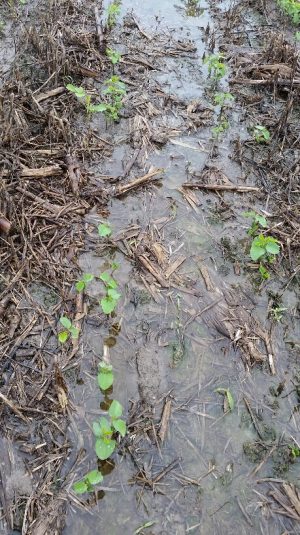
Flooded Soybeans – How Much Damage? What to do?
Rainfall across the state resulted in in saturated soils and sometimes flooded soybeans or fields to be planted in soybean. Although fields are drying out, more rain is expected this weekend.
It’s difficult to know the long-term effect of flooding on soybean fields. Research is limited, but we do know that the fate of flooded fields will largely depend on 1) the development stage during which the flood took place; 2) the duration of the flood; 3) the temperature during and right after the flood; and 4) the drying rate after the flood.
Basically a flooded field depletes the roots of oxygen (O2), causing photosynthesis to slow. After several days without O2, the plant may turn yellow, grown very slowly, and possibly die. Other indirect effects of flooding can include reduced nitrogen-fixing bacteria (but they will recover), nutrient imbalances, and increased disease pressure.
For more detailed information, see a blog post that I wrote in 2013 at the Virginia Soybean Update site.
In short, here are a few pointers for flooded fields. If soybean have not yet been planted: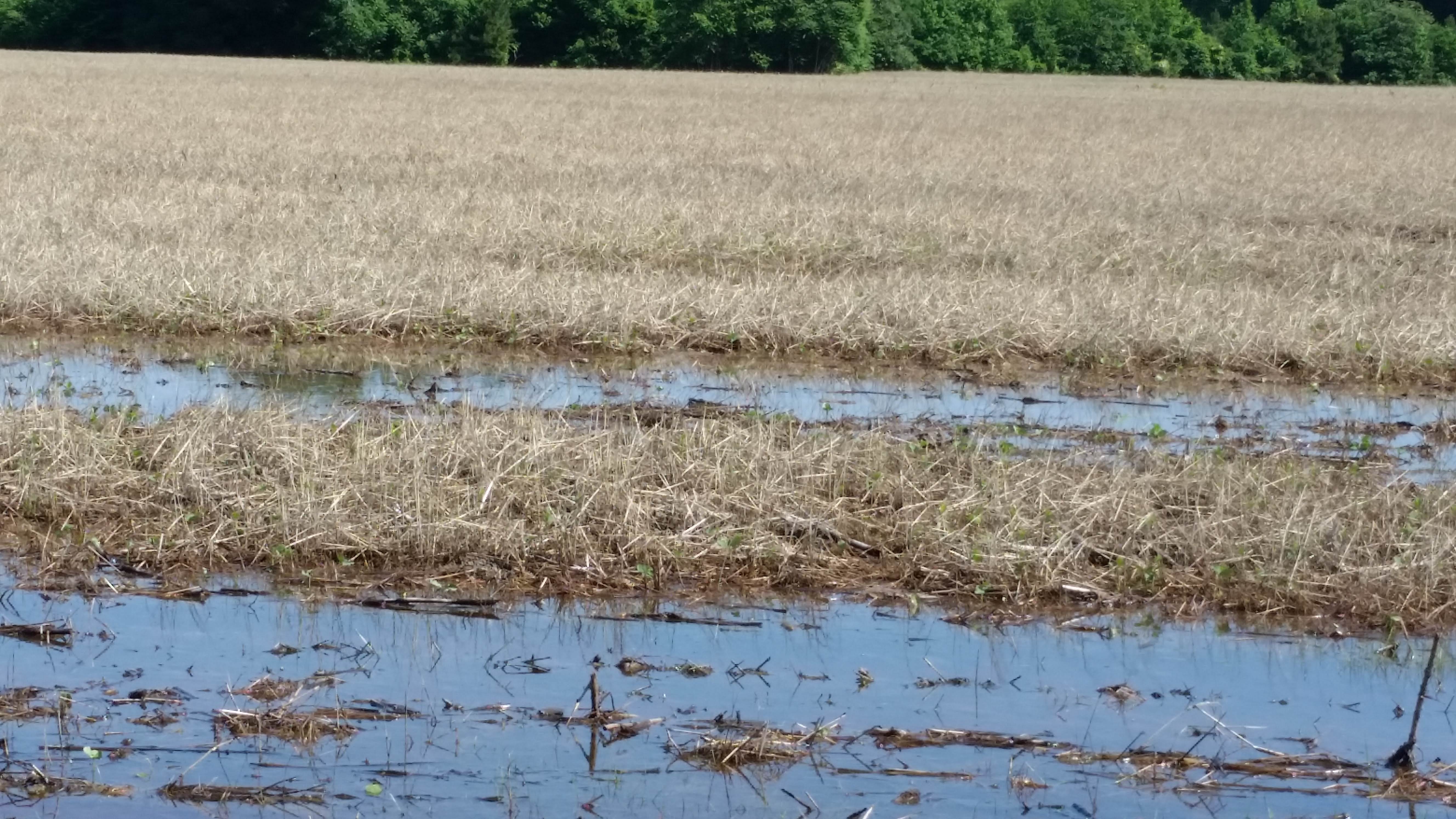
- I don’t recommend tillage to dry the soil out for continuous no-till fields. Tillage will destroy the soil structure that you’ve built since tillage was stopped. The field is probably draining better than it ever was; tillage will just cause water to stand longer in the future.
- Bradyrhizobia japonicum, the nitrogen-fixing bacteria that helps provide soybean with that nutrient, is harmed by lack of oxygen caused by the flood. Although the bacteria will recover, it may be prudent to add inoculant to the seed in areas that were flooded.
For flooded fields that have been planted: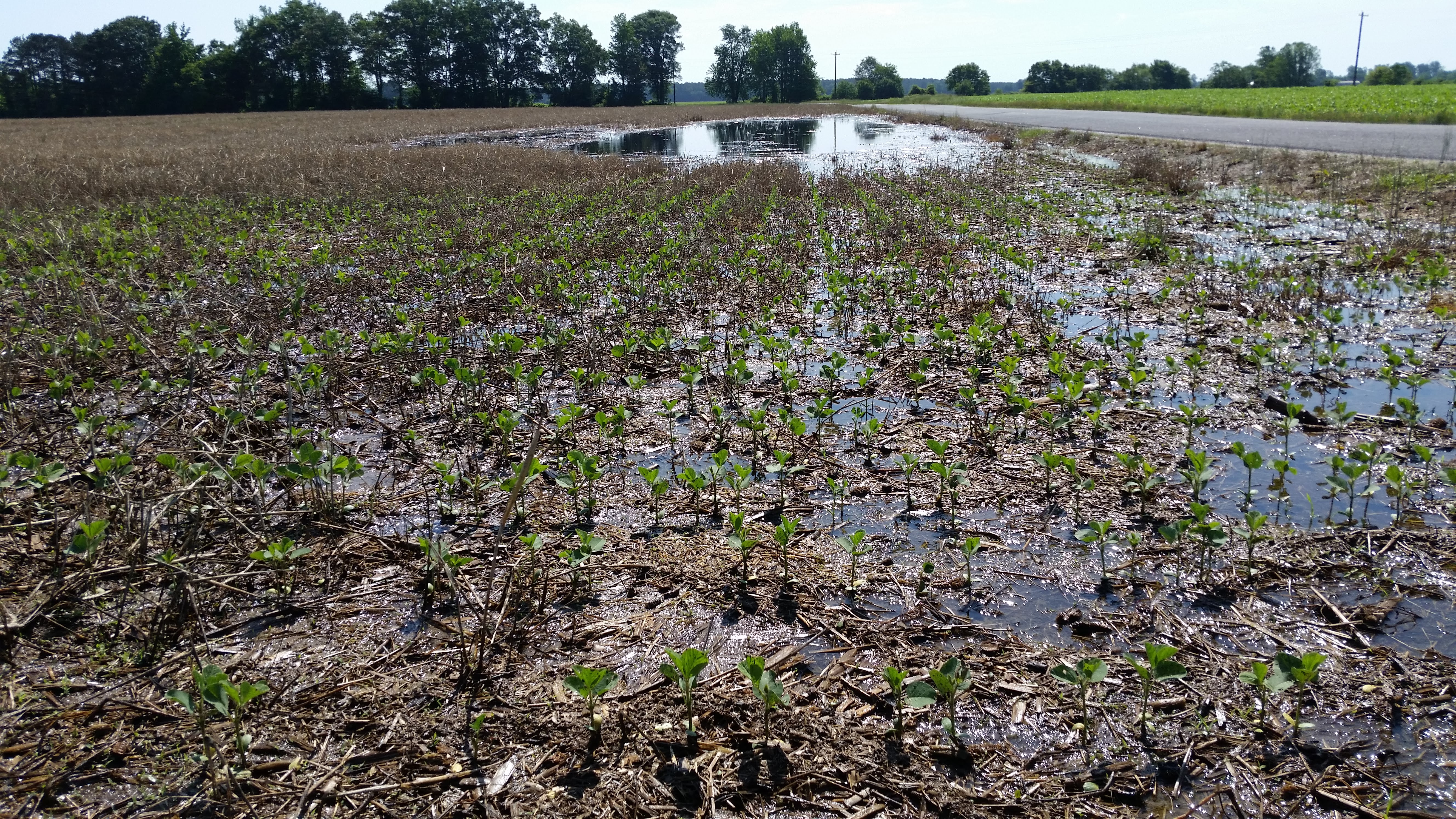
-
- Minimize any addition stress by staying out of the field. Do not try to plant or replant too soon. More damage can be done to the soil and more yield can be lost from planting into we soils than from planting too late.
- If soybean have not yet emerged and crusting evident, light tillage with a rotary hoe will help emergence.
- Evaluate the stand. If a stand reduction occurred, determine if it’s worthwhile to replant. Remember that after mid-June, every day delay in planting will cost you about ½ of a bushel in yield. The plants that remain are still higher yielding than seed that can now be planted, even if the stand has been substantially reduced.
- Stress such as herbicide injury can slow the crop down further. Still, weeds need controlling. But you may want to select herbicides (usually as tank-mix partners to glyphosate) that don’t cause a significant amount of burning.
- Finally, some will want to apply some type of foliar fertilizer to the crop to “kick-start” it back to health. I see little advantage of this. Remember that the real problem is lack of O2 to the roots and CO2 buildup in the soil; only after the roots begin to receive O2 will the recovery process start.Hopefully you haven’t experienced severe flooding (> 24 hours). But if so, be patient and evaluate the field. Then make good decisions on how to handle it.
New Crop Disease Management Resources
Though it has been around for several years, the Crop Protection Network (CPN) has recently added several publications on disease management in corn, soybean, and small grains that are relevant to growers, crop consultants, and extension personnel in Virginia and the surrounding region. These can be accessed at the CPN website cropprotectionnetwork.org. As stated on the website:
“The Crop Protection Network (CPN) is a multi-state and international partnership of university and provincial Extension specialists, and public and private professionals that provides unbiased, research-based information. Our goal is to communicate relevant information to farmers and agricultural personnel to help with decisions related to protecting field crops.”
Extension specialists throughout the country (including myself) contribute to the publications and other resources posted on the website. An example of a recent publication on optimizing fungicide use for control of Fusarium head blight can be downloaded below. The CPN library includes over 30 publications on crop management, and additional publications are in development.
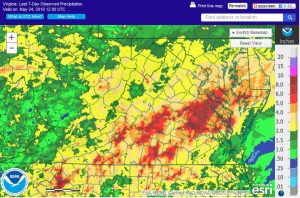
Be Careful Planting Into Wet Fields – We Still Have Time to Maximize Soybean Yield
Recent heavy rains have led to temporary flooding of numerous soybean fields throughout Virginia and put us behind with soybean planting . Only 26% of the crop was planted as of last week. And it looks as if we will have another bout of rain this weekend.
Although you will be tempted to get back into these fields as soon as possible, I caution you to hold off until the entire field dries to a point where you will not damage the soil, especially around the seed. Planting into wet soils can compact the soil around the seed, making rapid seedling growth difficult. For continuous no-till fields, you can also cause some long-term compaction that will not be easily removed without tillage. I usually advise to wait another half or full day before you think you can get back into the field. In the long run, it will likely pay off.
When should we get into a big hurry to plant? Planting date research indicates that we usually don’t see a rapid decline in yield until mid-June. Below is some Virginia research to verify this.
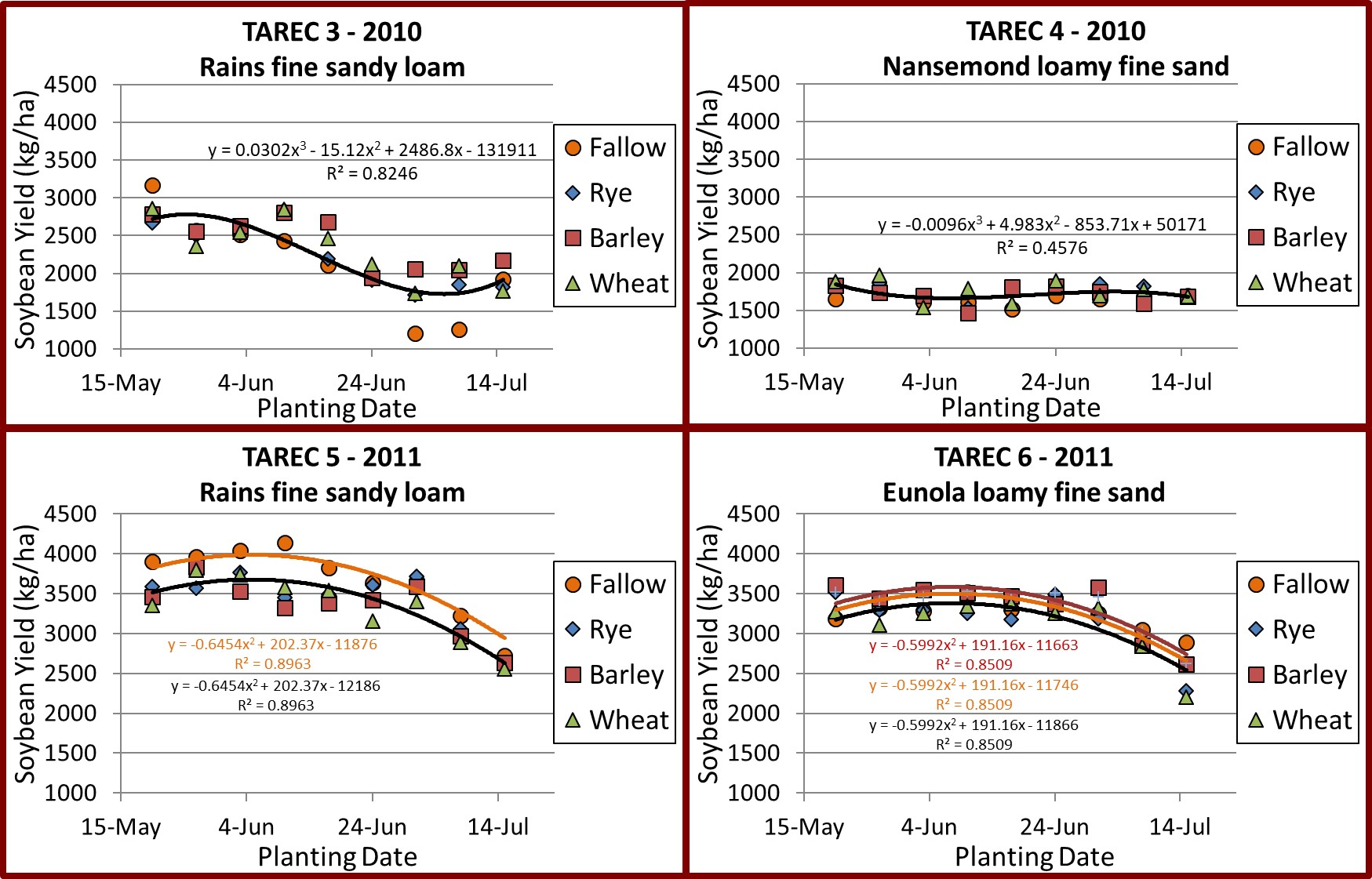 Although the below multi-state data is double-crop soybean, it also illustrates the point well.
Although the below multi-state data is double-crop soybean, it also illustrates the point well.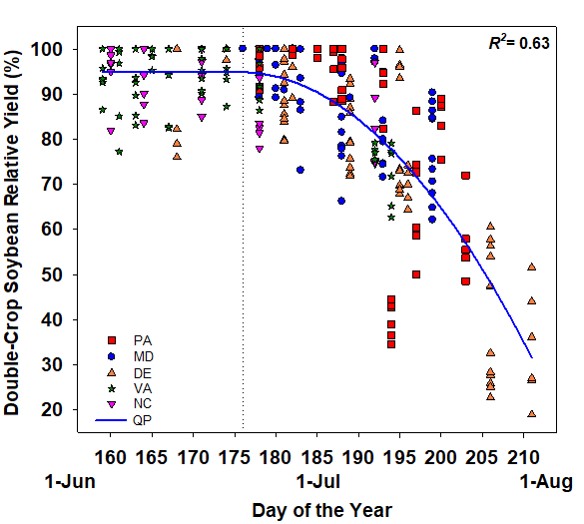 So, you are likely to lower your yield much more by planting too wet than delaying the planting (or re-planting) until the last week of May or the first week of June. Still, only you know your operation. If you still have hundreds, or maybe even thousand acres to go, you may not want to wait too late.
So, you are likely to lower your yield much more by planting too wet than delaying the planting (or re-planting) until the last week of May or the first week of June. Still, only you know your operation. If you still have hundreds, or maybe even thousand acres to go, you may not want to wait too late.

